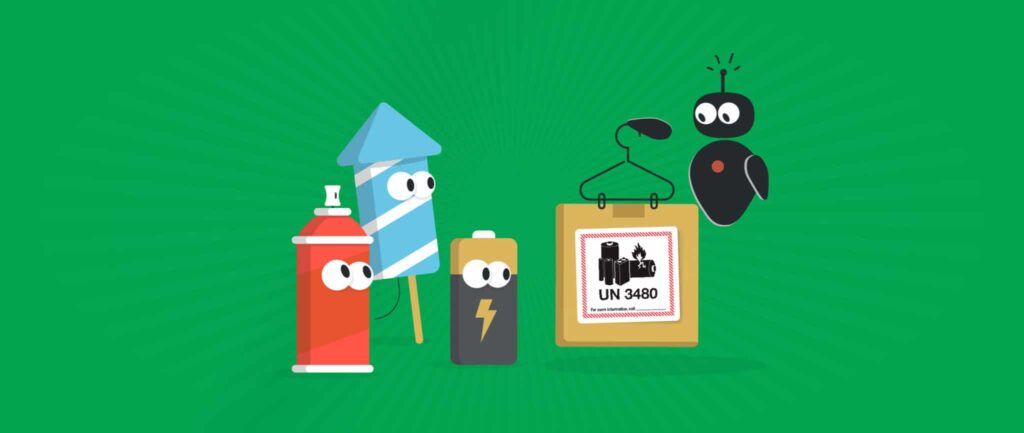Your products may be dangerously good, but did you know they can also be actually dangerous? Hazmat (short for hazardous) products contain substances that can be flammable, pressurized, corrosive, or otherwise just plain harmful, which basically means that they pose serious risks during the fulfillment process. From storing to handling to transporting, there’s a lot that goes into getting orders to their final destination, which is why taking the right precautions with hazmat products is of utmost importance.
If you have, suspect to have, or are planning to have, a hazmat product in your mix, this article is for you!
What’s Considered Hazmat?
Although “hazmat” can sound like a scary term, tons of everyday products would be classified as such. To make things a little easier, the U.S. Department of Transportation breaks hazmat materials down into nine different categories. Here’s a quick overview:
- Class 1: Explosives (Ammunition, gun powder, fireworks)
- Class 2: Gases (Hairspray, fire extinguishers, spray paint)
- Class 3: Flammable and Combustible Liquid (Gasoline, nail polish, paint thinner)
- Class 4: Flammable Solid, Spontaneously Combustible, and Dangerous When Wet (Coal, matches, sulfur)
- Class 5: Oxidizer and Organic Peroxide (Bleach, chlorine, hydrogen peroxide)
- Class 6: Poison and Poison Inhalation Hazard (Arsenic, biomedical waste, nicotine)
- Class 7: Radioactive (Medical isotopes, x-ray machines)
- Class 8: Corrosive (Drain cleaner, mercury thermometers, paint stripper)
- Class 9: Miscellaneous (Dry ice, lithium-ion batteries, vehicles)
Of course, the above examples are not comprehensive. To be 100% sure of where you stand, find your product’s Safety Data Sheet, or SDS, which is provided by your manufacturer. Your product’s hazard status can be found under “Transportation Information.” Keep in mind that it is ultimately the shipper’s responsibility to ensure proper classification, so it always makes sense to double and then triple check what you see — that means Googling, calling, and emailing. When it comes to hazmat shipping, thorough is the name of the game.
So My Product Is Hazmat… Now What?
As you might have already guessed, hazmat products are safely shipped and delivered everyday. The trick, much like international shipping, is to follow the rules to a T.
Start (and End) with the Carrier
Before you embark on your hazmat journey, don’t forget to check in with your carrier of choice to see what their specifications are. UPS, USPS, FedEx, and DHL all ship hazmat, but their requirements and restrictions will vary. On top of that, a certification is required for anyone who handles and ships hazmat materials. Talk about extensive!
Pro Tip: If you’ve been thinking about outsourcing your fulfillment, hazmat shipping might be the perfect opportunity to do so. 3PLs are pros on all things shipping, which means less headaches on your end. If you ask us, that’s pretty invaluable!
Package, Classify, & Label
In order to get this step right, refer back to the SDS we talked about earlier. You should find the ID number, proper shipping name, hazard class, and packing group for your product. Once you’ve located this information, refer to the Hazardous Materials Table for additional specifications, provisions, and exemptions.
When it comes to packaging, there’s simply no room for anything less than perfect — after all, these are potentially dangerous substances that we’re dealing with. Performance-oriented packaging serves as a guide for hazmat materials, with recommendations that have been thoroughly tested by the UN. In addition to packaging, it’s also important to get acquainted with hazmat markings, labeling, and placarding for correct product identification.
Fill Out That Paperwork
If you want to avoid delays and hold ups, staying on top of your paperwork is non-negotiable. In general, here’s what you’ll most likely need to provide:
- A description of the hazmat product
- The identification number and proper shipping name
- The hazard class and packaging group
- The total quantity of hazmat materials, including number and type of packaging
- The shipper’s hazmat certification and emergency contact information
Depending on the exact nature of the product(s) being shipped, additional paperwork may be required — check the Code of Federal Regulations to see if that’s the case.
Despite the challenging nature of hazmat shipping, it is a necessary aspect of many eCommerce businesses. While this is by no means an exhaustive guide, we hope we’ve been able to guide you through some key considerations. If we had any last bits of advice, it would be this: Always err on the side of caution.
Questions? Don’t be afraid to reach out!





